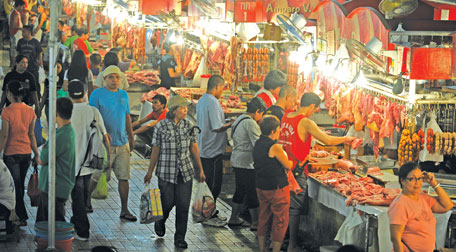|
Global food crisis not yet over :
Millions of Asians to face poverty
The global food crisis is not yet over and international agencies
warn over adverse repercussions of food shortage and high food prices on
the millions of poor in the world.
The latest report released by the Asian Development Bank last week
said that world food prices that surged 30 percent in the first two
months of the year threaten to push millions of Asians into extreme
poverty and cut economic growth.
"The surging prices translated into domestic food inflation of 10
percent on average in many Asian economies, which could drive 64 million
people into poverty.
It will also erode the living standards of families already living in
poverty" the Bank said.
 |
|
Meats are displayed at a wet market in
Quezon City, east of Manila on April 26, 2011. Soaring
global food prices threaten to push tens of millions of
Asians into extreme poverty and cut the regionís economic
growth this year, the Asian Development Bank warned in a
report. AFP |
The report illustrated the reasons for the food price increase.
Food prices have been driven higher by surging oil prices, production
shortfalls due to bad weather and export restrictions by several food
producing countries.
If high food and oil prices persist for the rest of the year, they
could save as much as 1.5 percentage points from economic growth in
developing Asian countries, the report said.
According to the report some countries will be hit harder than
others.
Singapore is highly vulnerable to inflation because the tiny
city-state must import all its food.
On the other hand, South Korea, where food accounts for a relatively
small part of the consumer price index, will get off more lightly. The
rapid increase in the cost of food is a serious setback for the region
that has rebounded rapidly from the global economic crisis. Declining
grain stocks, higher demand from Asian countries with big populations
that are growing wealthier, and a dwindling amount of agricultural land
will continue to keep food prices high in the short term, as will
competition for food grains from biofuel production and stagnant or
declining crop yields.
Drought in China's major wheat-producing belt and flooding in
rice-producing regions of Asia have reduced supplies of those crops.
ADB Chief Economist Changyong Rhee has told that food export bans and
other short-term measures should be avoided.
Instead, he urged greater spending to boost agricultural productivity
and more investment to improve irrigation, food storage and other
infrastructure.
"Left unchecked, the food crisis will badly undermine recent gains in
poverty reduction made in Asia," he said.
Poor families in Asia are hit much harder by food price inflation
because they spend as much as 60 percent of their income on food, a much
higher proportion than in developed countries. Asia's developing
countries are home to two-thirds of the world's poor - about 600 million
people - who live on $1.25 a day or less. In contrast, people in the
U.S. and other wealthy countries spend about 15 percent of their income
on food, so the impact on rising food prices on their wallets isn't as
big.
And a lot of the food sold in wealthy countries is processed, so
manufacturing costs account for a bigger share of the final price.
The ADB is a development lender whose mission is to alleviate poverty
through loans, grants and assistance projects.
Global food prices jumped 34.2 percent in February over a year ago
following a 28.4 percent rise in January, according to the Food and
Agriculture Organisation's (FAO) benchmark index. Surging cereal, edible
oil and meat prices were behind the increases.
The FAO warned that 29 countries in Africa, Asia, Middle East and
Latin America and the Caribbean would need food assistance.
Afghanistan and Pakistan are among those that will face severe food
shortages in part due to factors such as social unrest and ethnic
conflicts.
Cambodia and Laos also face unfavourable prospects for crops due to
delayed and erratic rains.
Meanwhile, a World Bank report says that since June 2010, an
additional 44 million people fell below the $1.25 poverty line as a
result of higher food prices.
Simulations show that a further 10 percent increase in the Food Price
Index could lead to 10 million people falling into poverty, and a 30
percent increase could increase poverty by 34 million people.
Low-income and lower-middle-income countries are experiencing on
average 5 percent points higher food price inflation compared to
better-off countries.
A special focus on the Middle East and North Africa region on this
issue shows double-digit food price inflation in Iran, Egypt and Syria,
with more moderate levels in other parts of the region. Global maize
prices are 17 percent higher in the first quarter of 2011 compared to
the last quarter of 2010, due to increasing demand for industrial uses
and low stocks.
Several countries in Sub-Saharan Africa have faced double-digit
increases in maize prices during the first quarter of 2011.
A comparison of price changes within countries shows that price
spikes, and therefore poverty impacts, can be highly localised.
Immediate actions include targeting social assistance and nutritional
programs to the poorest in areas where food prices have spiked.
Macro-policy measures need to be informed by the extent that
commodity price increases are feeding into inflationary expectations;
net commodity importers need to monitor external sector vulnerability.
Policy actions that will reduce the pressures on tight global food
markets include relaxing biofuel mandates when food prices exceed a
threshold level and removing export restrictions on grains.
GW
|

